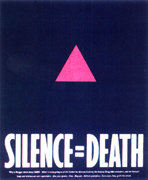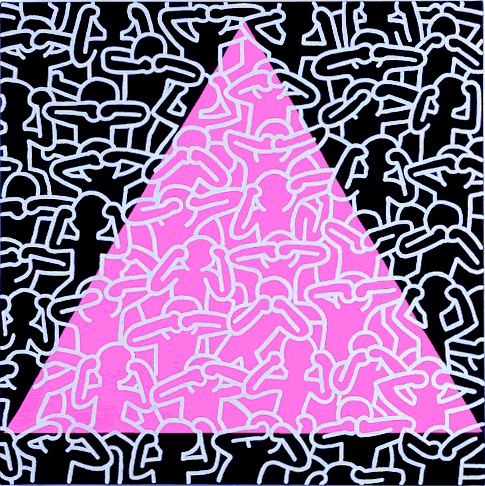December 06, 2003
Silence Still Equals Death

When Political Art Mattered is article no. 2 linked today from the NYT mag. The first couple pages are especially potent, touching on the power to the Silence = Death pink triangle and then skirting towards issues of privilege:
AIDS made its debut among a very cultured group of people. Many were artists who, devastated and enraged, turned their professional skills to protest. The design collective Gran Fury was founded in 1988 after the New Museum offered Act Up a window to do with as it pleased; soon other museums nationwide were draping their paintings and scheduling protests on Dec. 1, which became the annual Day Without Art. But even those gay men who were not culture mavens by trade were knowledgeable amateurs; hiding, encoding and image management were a fundamental part of every homosexual's sentimental education. In short, the dying, and their friends, knew how to convey a message in the language of their times.
For Larry Kramer, it was that ''art'' -- the street theater, the protest graphics -- that mattered. ''It was the only thing we had, the only way we could get any attention,'' he says. The image-starved television news shows could not be bothered to cover claims that a drug company was overcharging for medications, but let a bunch of black-clad young protesters chain themselves to that drug company's headquarters, and the cameras were there en masse. How to get across the idea of governmental guilt in promoting a blood-borne disease? Bloody hands, of course, stenciled everywhere. Some of the street actions I saw in the late 80's were better produced than Off Broadway shows, complete with smartly edited scripts, disciplined chorus numbers and gorgeous accouterments. Act Up's greatest artwork -- furtively covering Jesse Helms's Virginia home in a giant custom-made condom -- made the crucial point that prejudice is as insidious a danger to society as H.I.V. But, formally speaking, it was pure Christo.
''We were a bunch of gay people; this is what we knew how to do,'' Kramer says. ''We knew how to pretend. We knew how to make things pretty.''
One of the most informative hours of life was spent in a meeting room of what is now the Drug Policy Alliance (support em) listening to a formerly prominent ACT UP member* describing the evolution of their protest.
Like the Black Bloc and Critical Mass, Act Up has no formal leaders and no acknowledged hierarchy. Whoever showed up was a member, and decisions where made as a group. The people who showed up were predominantly gay, urban and upper middle class. They were also in the midst of a crisis, with AIDS cutting a broad swathe of death through the community. Ronald Reagan and much of the political establishment was content to ignore the deaths that where sweeping through what was then a marginalized community.
The result was what history might see as the first full fledged guerilla media warfare campaign. The NYT mag highlights a lot of the more art /visual elements of it. From a tactile standpoint however the one that stands out clearest is ACT UP's first Washington DC action. In preparing for this action, the emerging local factions from around the country met in San Francisco to create a plan. The group from ACT UP's founding city, New York, stayed quiet as everyone debated the various cliche locations, Supreme Court, White House, etc. Finally the NY group stood up and announced that they planned to protest outside the Department of Health and Human Services offices in suburban Maryland.
Protests in the center of DC are merely part of backdrop. ACT UP only brought a thousand or two protesters to suburban Maryland, but the result was clearly, pure drama, not background scenery. ACT UP was news, and with the news came increased attention the AIDS crisis. Following quickly behind was a rapid opening up towards gay culture in American life.
Of course AIDS is still a huge unsolved issue, and homophobia still a problem, but there is also a hell a lot to be learned from the media techniques that have gotten things this far. Gay activists were probably the first repressed group to have access to major amounts of media technology and knowledge of their inner workings. Since then desktop publishing, the internet and digital video have changed the game dramatically. The weapons of media warfare are reaching the communities that need them most. Keep watch.

